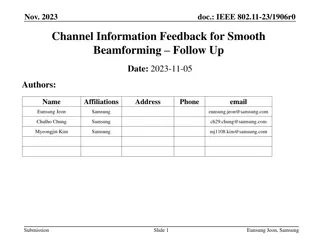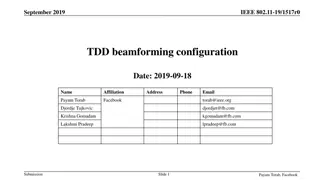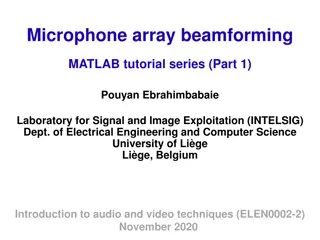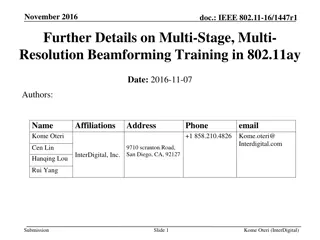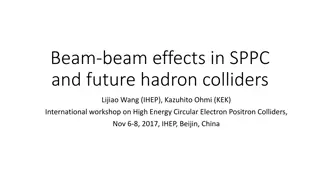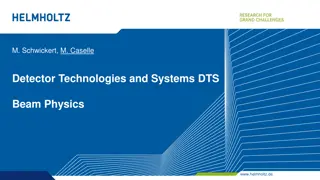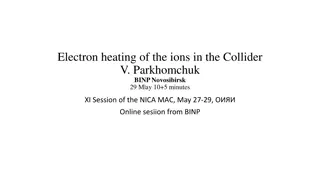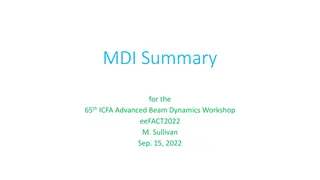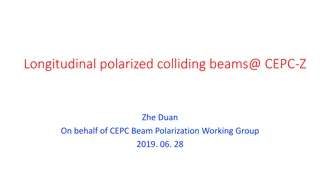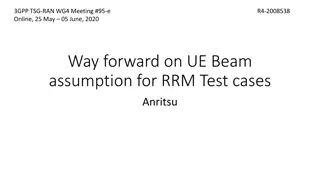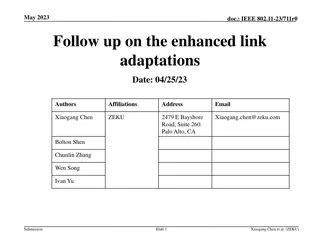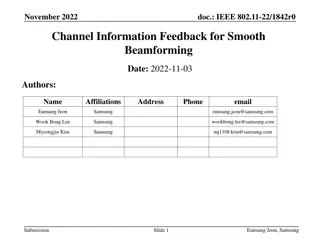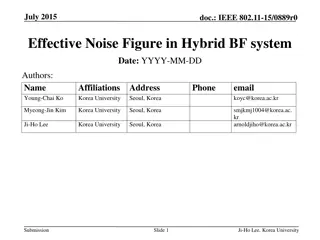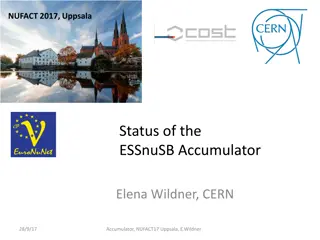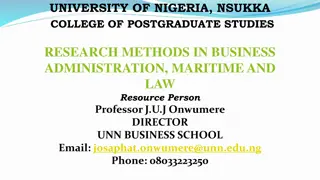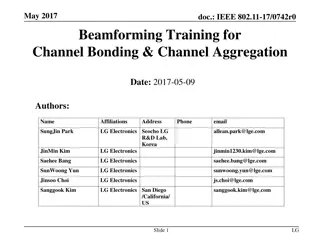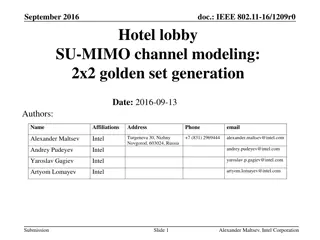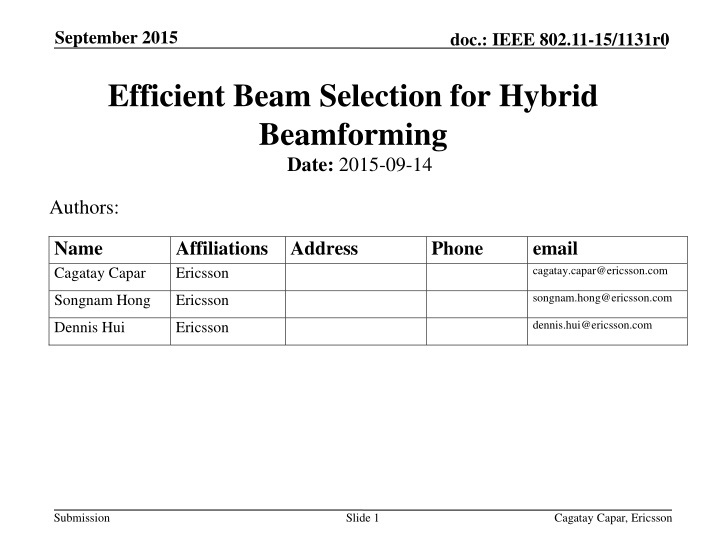
Efficient Beam Selection for Hybrid Beamforming in IEEE 802.11-15
This document investigates efficient beam selection for hybrid beamforming in IEEE 802.11-15 standard, focusing on the challenges and benefits of optimal beam selection in a multi-antenna array system. The study explores a novel algorithm for reducing search time and computational complexity while maintaining performance efficiency in beam selection for wireless communication scenarios.
Download Presentation

Please find below an Image/Link to download the presentation.
The content on the website is provided AS IS for your information and personal use only. It may not be sold, licensed, or shared on other websites without obtaining consent from the author. If you encounter any issues during the download, it is possible that the publisher has removed the file from their server.
You are allowed to download the files provided on this website for personal or commercial use, subject to the condition that they are used lawfully. All files are the property of their respective owners.
The content on the website is provided AS IS for your information and personal use only. It may not be sold, licensed, or shared on other websites without obtaining consent from the author.
E N D
Presentation Transcript
September 2015 doc.: IEEE 802.11-15/1131r0 Efficient Beam Selection for Hybrid Beamforming Date: 2015-09-14 Authors: Name Cagatay Capar Affiliations Address Ericsson Phone email cagatay.capar@ericsson.com songnam.hong@ericsson.com Songnam Hong Ericsson dennis.hui@ericsson.com Dennis Hui Ericsson Submission Slide 1 Cagatay Capar, Ericsson
September 2015 doc.: IEEE 802.11-15/1131r0 Abstract Beam selection for hybrid beamforming for 11ay is investigated. Optimal beam selection requires a number of computations that scale exponentially with the number of RF chains, which may be infeasible in practice. We investigate the performance of an efficient beam selection algorithm that works by matching transmit-receive antenna array pairs one by one, which reduces the search time significantly. For a simulated indoor scenario, beam selection with the proposed method shows minimal performance loss compared to exhaustive search. Submission Slide 2 Cagatay Capar, Ericsson
September 2015 doc.: IEEE 802.11-15/1131r0 Outline Introduction Hybrid Beamforming Beam Selection Simulation Results Summary and Conclusions Submission Slide 3 Cagatay Capar, Ericsson
September 2015 doc.: IEEE 802.11-15/1131r0 Introduction With MIMO included in 11ay, more than one antenna array per device will be allowed to be active. Beam selection is a necessary first step, where each antenna array needs to identify its best beam to use for transmitting or receiving. The number of beam combinations grows exponentially with the number of antenna arrays. With more than one antenna array on the transmit and/or receive side, beam selection becomes significantly more complex. Hence, efficient beam selection methods are of interest for 11ay. Submission Slide 4 Cagatay Capar, Ericsson
September 2015 doc.: IEEE 802.11-15/1131r0 Hybrid Beamforming RF RF H BB BB RF RF Hybrid Beamforming [1]: Beamforming done in two stages. 1) Coarse (Analog) Beamforming: Optimal sectors or antenna weights are selected. 2) Fine (Digital) Beamforming: Baseband precoding/combining is done. During analog beamforming, one set of beams is selected to form the effective (baseband) channel matrixH to be used for the fine beamforming stage. Once H is known, traditional MIMO techniques apply [2]. Submission Slide 5 Cagatay Capar, Ericsson
September 2015 doc.: IEEE 802.11-15/1131r0 Analog Beamforming Stage RF RF H BB BB RF RF 2x2 MIMO example: Beams are selected from a codebook. A codebook is a collection of antenna weight vectors. i1 : beam index for the first transmit array i2 : beam index for the second transmit array j1 : beam index for the first receive array j2 : beam index for the second receive array H=H(i1, i2, j1, j2) - Ideally, the set of all possible H s should be checked to find the optimal beams. Submission Slide 6 Cagatay Capar, Ericsson
September 2015 doc.: IEEE 802.11-15/1131r0 Exhaustive Search for Beam Selection ??,?: Codebook for the ?th transmit array ??,? : Codebook for the ?th receive array RF RF H ?1 {1,2, ,|??,1|} ?2 {1,2, ,|??,2|} ?1 {1,2, ,|??,1|} ?2 {1,2, ,|??,2|} BB BB RF RF 2x2 MIMO example: Beams are selected from a codebook. i1 : beam index for the first transmit array i2 : beam index for the second transmit array j1 : beam index for the first receive array j2 : beam index for the second receive array 11?1,?1 21?1,?2 12?2,?1 22?2,?2 ? = ,?2 ,?1 ,?2 to Goal: find the best set of beam indices ?1 optimize some metric ?(?). Exhaustive search: Calculate ? ? for all possible beam combinations. Suppose ??= |??,1|=|??,2|, ??= |??,1|=|??,2| Then, exhaustive search takes 2?? H=H(i1, i2, j1, j2) 2calculations. ?? Submission Slide 7 Cagatay Capar, Ericsson
September 2015 doc.: IEEE 802.11-15/1131r0 Exhaustive Search for Beam Selection 11?1,?1 1???1,??? RF RF ?(?,?) = B B BB ??1?1,??? ???????,??? H BB Goal: find the best set of beam indices ? ,? to optimize some metric ?(?). RF RF Exhaustive search: Calculate ? ? for all possible beam combinations. Suppose ??= ??,1 = = |??,??|, ??= ??,1= = |??,??| Then, exhaustive search takes ?? In general, ??transmit arrays, ?? receive arrays. Transmit array codebooks: ??,1, ,??,?? Receive array codebooks: ??,1, ,??,?? ???? ??calculations. Exponential in the number of antenna arrays! Submission Slide 8 Cagatay Capar, Ericsson
September 2015 doc.: IEEE 802.11-15/1131r0 Pairwise Search for Beam Selection First step: Do the first matching by finding RF RF ),(? ,?? )} = argmax { (? ,?? ?1( ????,??) ?,??,?,?? B B BB H Transmit array, and its beam Receive array, and its beam BB Note that the argument is just a scalar. This step takes ???????? calculations: Linear in ??,??. RF RF Second step: Find ),(? ,?? )} = argmax ?,??,?,?? ,??,?? ,??) ?2( ? ?? {(? ,?? Exhaustive search takes too much time. where ? is the 2x2 matrix seen between the two transmit and receive antenna arrays with the given beams. A faster (but suboptimal) way is to go pair- by-pair. For example, first find the array pair which gives you the strongest signal. Then keep matching arrays one pair at a time. This step takes ?? 1 ?? 1 ???? calculations. and so on Submission Slide 9 Cagatay Capar, Ericsson
September 2015 doc.: IEEE 802.11-15/1131r0 Pairwise Search for Beam Selection First level ?2,?2 combinations ?1,?2 combinations ?2,?1 combinations Second level Example for ??= 2,??= 2 This search can be described on a tree. The root node has ???????? children. Each child of the root has ?? 1 ?? 1 ???? children. Algorithm: At each level, find the best child and move along that path. A generalization is where you pick the ? best children at each level. Known as ?-algorithm [3]. When ? = ?? ???? ?? (keep only distinct paths), this becomes equivalent to exhaustive search. Submission Slide 10 Cagatay Capar, Ericsson
September 2015 doc.: IEEE 802.11-15/1131r0 Simulation Details Receiver fixed at one location. Several transmitter locations tested. Both transmitter and receiver have two antenna arrays 2x2 MIMO. Antenna arrays are 1x8 linear arrays placed on a line. Rx, Tx antenna array separation: 30 cm, 5 cm, respectively. For each transmitter location, full channel matrix (16x16) is generated by ray tracing. Room with reflectors and blockages: Rx Tx Submission Slide 11 Cagatay Capar, Ericsson
September 2015 doc.: IEEE 802.11-15/1131r0 (Pairwise) SNR-based Search SNR-based Search: At both levels, use signal power as the metric. Readily available, just the norm of the channel coefficient. Most direct, baseline method. In more than half of the locations, this search finds the same beams with exhaustive search, so no performance loss. Some loss at mostly distant locations. Room with reflectors and blockages: Rx Tx 10 2 9 1 3 81 Tx locations. For each location, beams are found both with exhaustive search and pairwise search. Once the beams are fixed, rate calculation is done assuming optimal baseband precoding (using SVD) with joint water filling across subcarriers and layers subject to a total power constraint. Rate loss shown as percentage of the rate achieved with the optimal beams found by exhaustive search. Submission Slide 12 Cagatay Capar, Ericsson
September 2015 doc.: IEEE 802.11-15/1131r0 (Pairwise) Rate-based Tree Search Rate-based Tree Search: Match the first pair using signal power, then calculate the rate to match the second pair. With this change, in almost all locations, the same beams with exhaustive search are found. This comes at the expense of a more complex calculation in the second level, however the number of calculations is still linear in the number of arrays. Room with reflectors and blockages: Rx Tx 10 2 9 1 3 SNR-based Search does not use the rate as the metric in any of the levels. In the locations with performance loss, we noticed SNR-based Search and exhaustive search usually share one beam pair, but differ on the other. In order to improve performance, we keep the same metric for the first level, but calculate the rate in the second level. Rate loss shown as percentage of the rate achieved with the optimal beams found by exhaustive search. Submission Slide 13 Cagatay Capar, Ericsson
September 2015 doc.: IEEE 802.11-15/1131r0 (Pairwise) Rate-based Tree Search Room with reflectors and blockages: Rx Tx 10 2 9 1 3 In the ?-algorithm, we keep ? candidates at each level of the search. Previous result corresponds to Rate-based Tree Search with ? = 1. Performance improves with increasing ?. With ? = 3, Rate-based Tree Search already chooses the same beams with exhaustive search in all locations. Rate loss shown as percentage of the rate achieved with the optimal beams found by exhaustive search. Submission Slide 14 Cagatay Capar, Ericsson
September 2015 doc.: IEEE 802.11-15/1131r0 Summary and Conclusions Optimal beam search becomes computationally complex in a MIMO scenario. A suboptimal search where transmit-receive antenna arrays are matched pairwise is an efficient alternative to exhaustive search. For a simulated indoor scenario, a pairwise search based on only signal power results in comparable performance. Furthermore, performance of the pairwise search can be improved by changing the metric used to match array pairs, or increasing the number of candidates kept in each array pair matching. Submission Slide 15 Cagatay Capar, Ericsson
September 2015 doc.: IEEE 802.11-15/1131r0 References 1. 11-14/0606r0, Next Generation 802.11ad: 30+ Gbps WLAN 2. 11-15/0334r1, MIMO Framework 3. J. B. Anderson and S. Mohan, Sequential Coding Algorithms: A Survey and Cost Analysis, IEEE Transactions on Communications, vol.32, no.2, pp.169- 176, Feb. 1984. Submission Slide 16 Cagatay Capar, Ericsson

